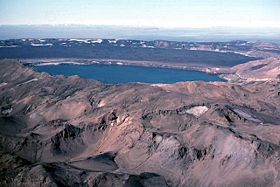Askja
| Askja | |
|---|---|

Askja caldera in 1984
|
|
| Highest point | |
| Elevation | 1,516 m (4,974 ft) |
| Coordinates | 65°01′48″N 16°45′00″W / 65.03000°N 16.75000°WCoordinates: 65°01′48″N 16°45′00″W / 65.03000°N 16.75000°W |
| Geography | |
| Parent range | Dyngjufjöll |
| Geology | |
| Mountain type | caldera |
| Last eruption | October to December 1961 |
Askja ([ˈascja]) is a caldera situated in a remote part of the central highlands of Iceland. The name Askja refers to a complex of nested calderas within the surrounding Dyngjufjöll mountains, which rise to 1,510 m (4,954 ft), askja meaning box or caldera in Icelandic
The region is only accessible for a few months of the year. Being situated in the rain shadow to the northeast of the Vatnajökull glacier, the area receives only about 450 mm of rainfall annually. The area was used during training for the Apollo program to prepare astronauts for the lunar missions. Their main objective in Askja was to study geology.
Askja was virtually unknown until the tremendous eruption which started on March 29, 1875. Especially in the eastern fjords of Iceland, the ashfall was heavy enough to poison the land and kill livestock. Ash, or tephra from this eruption was wind-blown to Norway and Sweden. The eruption triggered a substantial wave of emigration from Iceland. Another less well-known eruption occurred in the early Holocene, ca 11,000 years ago. Tephra from this eruption has been found in south-east Sweden, Northern Ireland and north Norway. The last eruption of Askja was in 1961.
The outer caldera of Askja, representing a prehistoric eruption, is about 50 km², and there is evidence of other later caldera-forming events within it. The main crater floor lies at about 1,100 m.
In June 2010, Volcano expert Hazel Rymer said seismic activity was increasing at Askja and that an eruption could be around the corner The increased earthquake activity is located to the northeast of the central volcano, in the direction of Herðubreið. It was ruled out that any activity from Eyjafjallajökull was responsible for the increase in activity at Askja. The news came as scientists continue to watch Katla.
...
Wikipedia

